Mad Hedge Biotech and Healthcare Letter
July 26, 2022
Fiat Lux
Featured Trade:
(ANOTHER TECH AND HEALTHCARE CROSSOVER)
(ONEM), (AMZN), (TDOC), (AMWL), (GOOGL), (AAPL), (MSFT), (CVS), (WBA), (UNH)

Mad Hedge Biotech and Healthcare Letter
July 26, 2022
Fiat Lux
Featured Trade:
(ANOTHER TECH AND HEALTHCARE CROSSOVER)
(ONEM), (AMZN), (TDOC), (AMWL), (GOOGL), (AAPL), (MSFT), (CVS), (WBA), (UNH)

The battle for telemedicine dominance might have just ended before it even began.
Amazon (AMZN) just announced its all-cash plan to acquire One Medical (ONEM) for $3.9 billion, paying $18 per share.
To date, this will be Amazon’s biggest step toward the healthcare world.
With the entry of Amazon into this telehealth segment, companies like Teladoc (TDOC) and Amwell (AMWL) would need to work overtime to match the resources of the e-commerce giant.
However, Amazon’s move isn’t exactly novel considering that other FAANG companies like Google (GOOGL), Apple (AAPL), and Microsoft (MSFT) have already acquired healthcare companies.
What this move simply indicates is that Amazon has finally turned serious in its bid for a bigger piece of the healthcare market.
This isn’t even the first time Amazon decided to go beyond its retail business. It has a pretty diverse portfolio including Amazon Web Services, a cloud infrastructure service, and even Whole Foods.
However, the decision to aggressively pursue the $800 billion healthcare industry might just be what Amazon needs to really move the needle.
In 2018, Amazon shelled out roughly $1 billion to buy an online pharmacy called PillPack which led to the launch of virtual Amazon Care clinics.
On that same year, the e-commerce company also pursued a joint venture, dubbed Haven, with Berkshire Hathaway and JPMorgan Chase. Unfortunately, that plan didn’t pan out and was eventually shut down.
Buying One Medical at a premium of 77%, Amazon beat other interested bidders including CVS (CVS), Walgreens (WBA), and UnitedHealth (UNH).
It’s still unclear what Amazon plans with One Medical. The e-commerce giant might add it to its Amazon Care brand or let it operate independently.
One Medical is a membership-based platform, which is backed by the Carlyle Group (CG) and managed under 1Life Healthcare.
Like most telehealth companies, it offers virtual healthcare services like virtual visits. What makes it different is that it also provides in-person checkups in accredited medical offices within the US.
One Medical’s app enables clients to schedule appointments, talk with their healthcare provider, and ask for prescriptions.
A key selling point is that the company guarantees that all the appointments start on time. Another notable feature is that users can gift a yearlong subscription to someone for $199.
Like Teladoc and Amwell, the company isn’t profitable yet. This case isn’t shocking for a relatively new field.
However, One Medical’s strategy has led to impressive revenue and membership growth.
The company’s revenue has consistently increased since its 2020 IPO. In 2021, its membership count climbed by 34% to reach 736,000.
In the first quarter of 2022, One Medical’s membership grew again by 28% and revenue jumped 109% to record over $254 million. So far, more than 8,000 companies provide One Medical services to their staff.
For 2022, One Medical projects its revenue to be between $831 million and $853 million.
Admittedly, these figures seem inconsequential when you compare them to the other sectors of Amazon’s business. For example, Amazon Web Services raked in $18.4 billion in sales in the first quarter of 2022.
Actually, One Medical’s revenue and membership growth might even look small and unimpressive compared to Teladoc, which recorded $565 million in the first quarter and has more than 54 million members in the US alone.
Undoubtedly, the healthcare market offers a mouthwatering opportunity for the likes of Amazon. It’s a lucrative industry, one of the handful that can truly make a difference in an already thriving business. Moreover, it has been highly profitable over the years.
Nonetheless, the acquisition of One Medical isn’t a foolproof plan for Amazon’s dominance in healthcare. So far, the e-commerce giant’s track record has been mixed. That doesn’t mean that the deal is a bad move. In fact, it indicates Amazon’s seriousness in making a play for the healthcare market.
Either way, the clear winner would be One Medical. Since the announcement, the stock has risen 70%.
Moreover, even if Amazon falls victim to politicization or anti-trust issues involving the deal, One Medical still has a number of suitors lined up.
Basically, it’s a win-win for this emerging telehealth company.
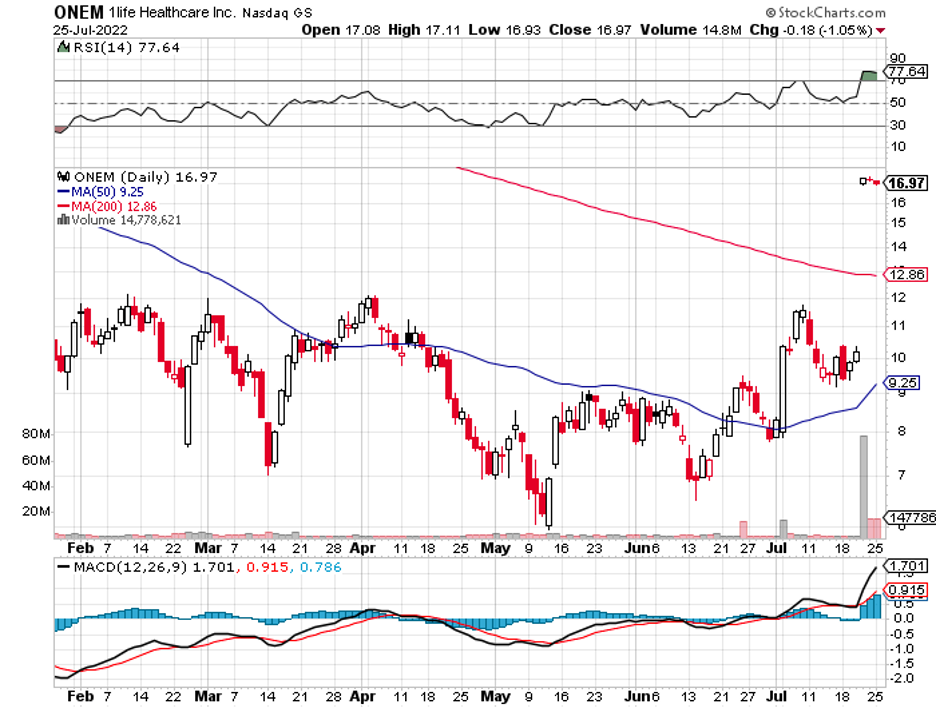
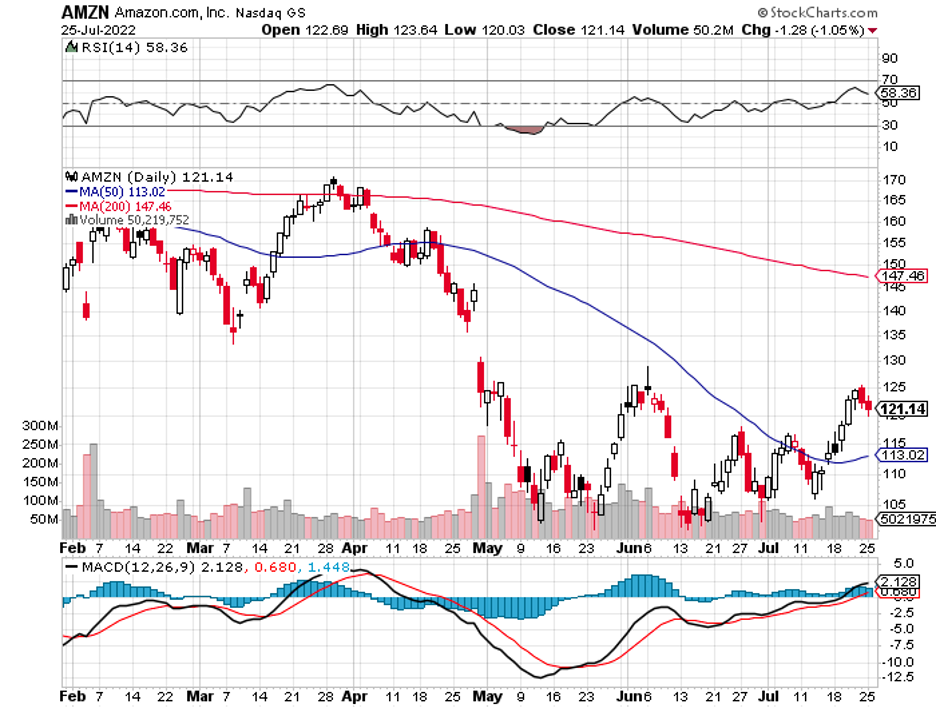
Mad Hedge Biotech and Healthcare Letter
October 28, 2021
Fiat Lux
Featured Trade:
(AN ANYTIME, ANYWHERE HEALTHCARE STOCK)
(TDOC), (AMZN), (AMWL), (WMT), (HIM)
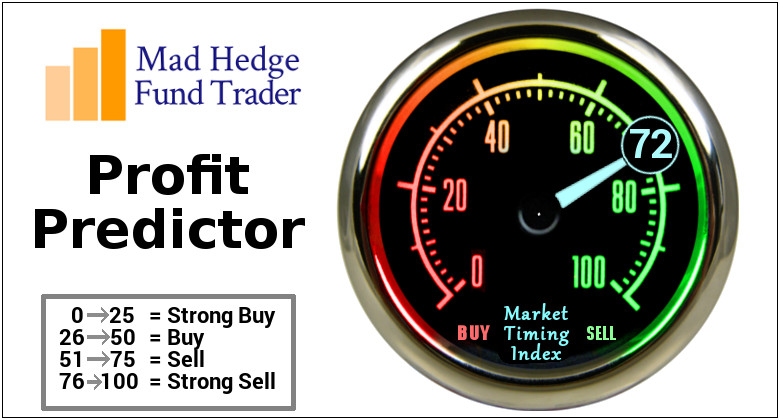
Following massive gains at the onset of the COVID-19 pandemic, several healthcare growth stocks have fallen a long way from their highs.
In fact, some high-quality names have become potential bargains due to the market's recent negative turn.
In this situation, we can apply Warren Buffett’s advice: "We simply attempt to be fearful when others are greedy and to be greedy only when others are fearful."
That is, I think it might just be the time to be a bit greedy.
One of the companies affected by the massive pullback is Teladoc (TDOC).
Over the past 1.5 years, Teladoc has been on a rollercoaster ride when it comes to its price action.
Initially, the stock was regarded as merely a COVID-19 pandemic play with limited growth in the future.
Because of that perception, Teladoc's price started to drop the moment the people got their vaccine shots.
Some investors believe that when things go back to normal, the whole telehealth industry will become pointless.
I don't think that's the case.
I believe that digital medicine and the presence of virtual health services will become mainstays in our lives—and Teladoc is in an enviable position as one of the pioneers in this disruptive industry that's only starting to take on the healthcare system by storm.
When the pandemic started, it was nearly impossible for most people to gain access to healthcare.
Most patients were scared to travel to the doctor for consultations, causing them to cancel and postpone appointments.
What Teladoc offered is to turn the impossible possible for several patients who needed access to their healthcare providers—and its efforts were rewarded in spades.
In 2019, Teladoc reported $553 million in total revenue, increasing by 32% from its 2018 earnings.
By 2020, the business exploded to reach a whopping $1.09 billion, showing a massive 98% growth year-over-year. Moreover, visits and consultations skyrocketed by 206%.
To hold on to its lead, Teladoc has been working hard to bolster its competitive positioning. It seized a blockbuster acquisition and bought Livongo for $18.5 billion in cash and stock.
Adding Livongo to its portfolio means cornering the market on remote monitoring for patients suffering from chronic diseases.
This addition to its business not only expands Teladoc's business, but also opens a massive addressable market worth $50 billion to the company.
Teladoc can leverage this vast network through cross-selling products and services, thereby creating the Amazon (AMZN) of the healthcare world—a platform with an unbeatable ecosystem and an irresistible value proposition.
Since the merger, the two companies have developed a full-person digital healthcare platform called Primary360.
Meanwhile, Teladoc's growth story carries on, with the total revenue for 2021 already approaching the $2 billion mark.
This signifies an impressive 84% increase on top of the company's COVID-19-induced spurt.
As for 2022, Teladoc is projected to grow at a conservative 29%.
Despite the impressive growth of Teladoc, the company has barely scraped the surface.
Overall, the virtual care market is estimated to be worth $250 billion annually. Although Teladoc holds the most significant share thus far, it's evident that it has less than 1% of the market share.
In fact, the telemedicine industry is projected to be valued at half a trillion dollars globally by 2030.
Considering that Teladoc's yearly revenue thus far is sitting at only $2 billion, the company definitely has a lucrative growth runway in the coming 9 years.
In 2020, its stock price roughly tripled from being under $100 to reaching $300. Recently, though, Teladoc's price has gone down to approximately $130.
Given its obvious room for growth, I say this stock is undervalued. So, investors are granted the chance to add this company to their portfolio at a relatively low price.
With the massive market potential of this industry, it comes as no surprise that Teladoc now faces intense competition in the field.
The strongest rivals of the company in the telehealth segment include Amwell (AMWL), Walmart (WMT), Hims and Hers Health (HIM), and even Amazon.
With the market's sheer size, though, the situation doesn't seem to be a winner-takes-all type.
The space is definitely massive enough to support more than one telehealth company.
However, Teladoc does have the advantage as the first mover. It also has its impeccable partnership with Livongo, making it an anytime-anywhere-healthcare service.
So far, I can say that Teladoc is off to an excellent start in a rapid growth segment. I especially appreciate the company's goal to disrupt the medicine and healthcare space—a field that is in dire need of a revolution to eliminate the debilitating costs and crippling inefficiencies.
More than that, I think Teladoc is becoming instrumental in boosting the reach of the most effective medical professionals and offering a remarkable platform to promote artificial intelligence innovation in healthcare.
Ultimately, this will help enhance the quality of healthcare received by patients.
When looking at disruptive technologies, I always say that it's best to invest in companies working to shape the future.
This goal is typically a surefire way to make money in the long run, and Teladoc perfectly suits the description.
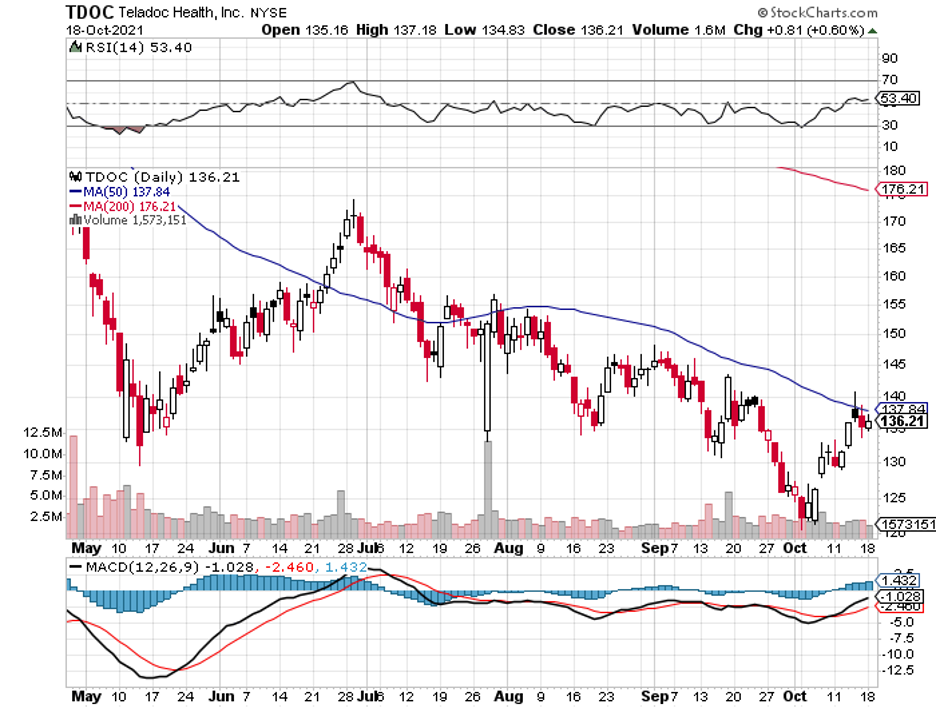
Mad Hedge Biotech & Healthcare Letter
July 20, 2021
Fiat Lux
FEATURED TRADE:
(A SNAPSHOT ON HOW TO LIVE A BETTER LIFE)
(DXCM), (CVS), (WBA), (RAD), (MDT), (ABBT), (SENS),
(TDOC), (AMWL), (AMZN), (AAPL), (GOOGL), (GRMN)
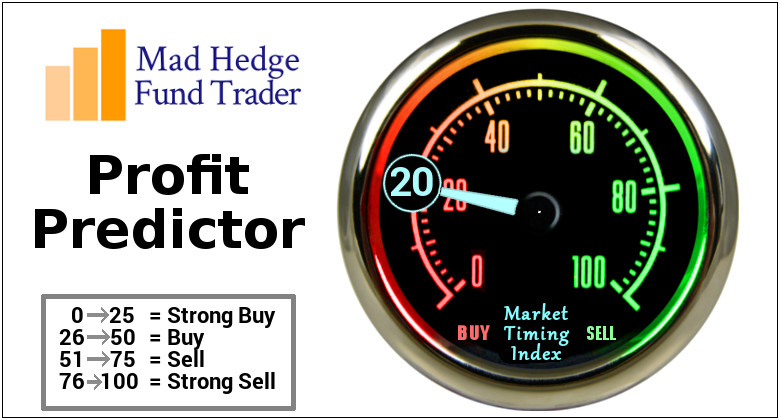
The routine medical check-ups we have today are primarily based on physical exams that were developed way back in the 1820s, utilizing tools that haven’t been upgraded for over a century.
More alarmingly, all we go through is a “comprehensive” health check once every year, offering us just a snapshot of what’s truly going on in our bodies.
If anything, we monitor the releases of new software for our phones and laptops more than we pay attention to our own bodies.
As we’ve proven with the COVID-19 pandemic, so much can happen in a year
Truth be told, our bodies can deteriorate at lightning speed and without any warning. That’s why it’s terrifying to think that we’re not doing as much to monitor our health.
So, what can we do to change this? How can we be more proactive when it comes to our health?
The COVID-19 pandemic has brought many changes into our lives, and this is one of the biggest transformations it has done: an exponential spike in demand for telehealth services.
One of the major issues between patients and doctors at the height of the pandemic was how to go through the physical exams without actual physical contact.
Clearly, it’s not possible to hear a heart murmur or irregular breathing over a video call.
This is where a lot of innovative companies come in.
For a more specialized exam, HD Medical released a credit card-sized device called HealthyU.
Patients simply touch it with their finger, and the device can instantaneously measure their heart rate and sounds, temperature, and even oxygen saturation.
All these data would then be sent to their doctors or health providers in real-time.
HealthyU also has a remote EKG, which effectively allows it to serve as a portable roadmap to a patient’s heart health and helps doctors monitor for signs of heart attacks and arrhythmias.
For example, there’s this handheld exam kit called Tyto that patients can use to perform their own guided medical exams.
This palm-sized gadget is linked to an app, so your doctor can monitor you remotely.
Patients suffering from a sore throat can use Tyto’s camera to let the doctors see the back of their throats, while those struggling from chest pains can easily use the stethoscope to help their physicians listen to their lungs and hearts.
And these are just for physical exams. There are more advancements in health monitoring, and this is where wearable technology comes in.
Wearable technology is considered one of the most promising growth drivers, largely due to the health sector.
The market size for this segment is estimated to rise from $116.2 billion in 2021 to $265.4 billion by 2026, showing off an 18% CAGR growth within a 5-year period.
Applications for wearables have expanded to areas including medical surgery as well as internables and implantables or sensors, which can be fitted into our bodies to help doctors observe various health parameters.
It’s no wonder brands like Apple (AAPL) with Apple Watch, Google (GOOGL) with Fitbit, and Garmin (GRMN) have been working overtime to try to cover as much of the wearable health market as possible.
So far, these products provide extensive data ranging from calories burned to our heart rates.
Aside from them, there are other wearables in the market today that could change the landscape of the health industry.
One of them is the Oura Ring, which was first introduced in 2013.
Designed to be worn 24 hours a day, this device measures the bodily functions of the user. It gathers data through infrared light sensors that touch the finger arteries.
One of the most impressive things it can do is monitor your sleep movements to help determine early onset of some neurodegenerative diseases like Parkinson’s.
The information is all sent to the app, which users can access via their smartphones. The Oura Ring is somewhere between $299 and $999, depending on your preferences in style and color.
Although it’s yet to be a mainstream product, the Oura Ring was provided to NBA players when they resumed their season amid the COVID-19 pandemic.
The device was used to help the basketball stars monitor their health.
In fact, a joint study with the University of California San Francisco showed that the Oura Ring was able to help detect the common symptoms of COVID-19 three days earlier and with as high as 90% accuracy.
Another impressive health monitoring advancement covers the glucose monitoring product line of Dexcom (DXCM).
The primary goal of Dexcom is to take away the guesswork that comes with finger pricking.
By offering a wearable sensor, people with diabetes can easily and accurately monitor their glucose levels.
What’s even more convenient is that Dexcom’s wearable is available in practically all large pharmacies like CVS (CVS), Walgreens (WBA), and Rite Aid (RAD).
To date, Dexcom’s biggest competitors include Medtronic’s (MDT) Guardian Connect, Abbott’s (ABBT) Freestyle Libre, and Senseonics’ (SENS) Eversense.
These are only some of the emerging technologies that could help us improve the quality of our lives today, with thousands more expected to follow suit in the years to come.
For an endlessly advancing world with smartphones, supercomputers, smart homes, and even self-driving cars receiving software updates virtually every week, it’s absurd to think that we only allot a single check-in on our health annually.
But with the advent of these technologies and the increasing popularity of telehealth services spearheaded by the likes of Teladoc (TDOC), Amwell (AMWL), and even Amazon (AMZN), it looks like we’re starting to finally pay more attention to our health.
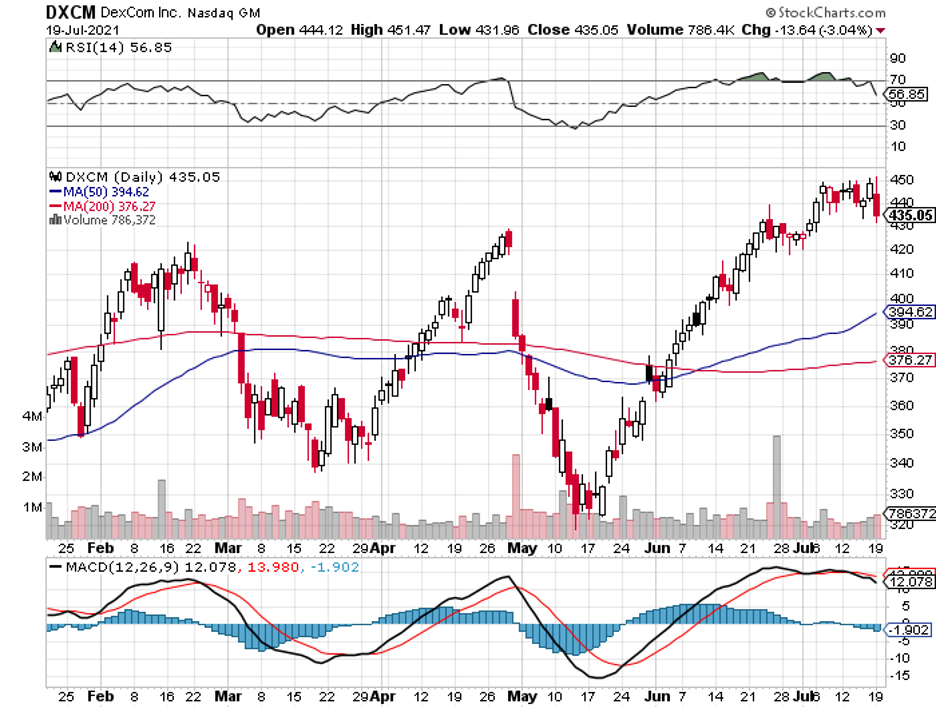

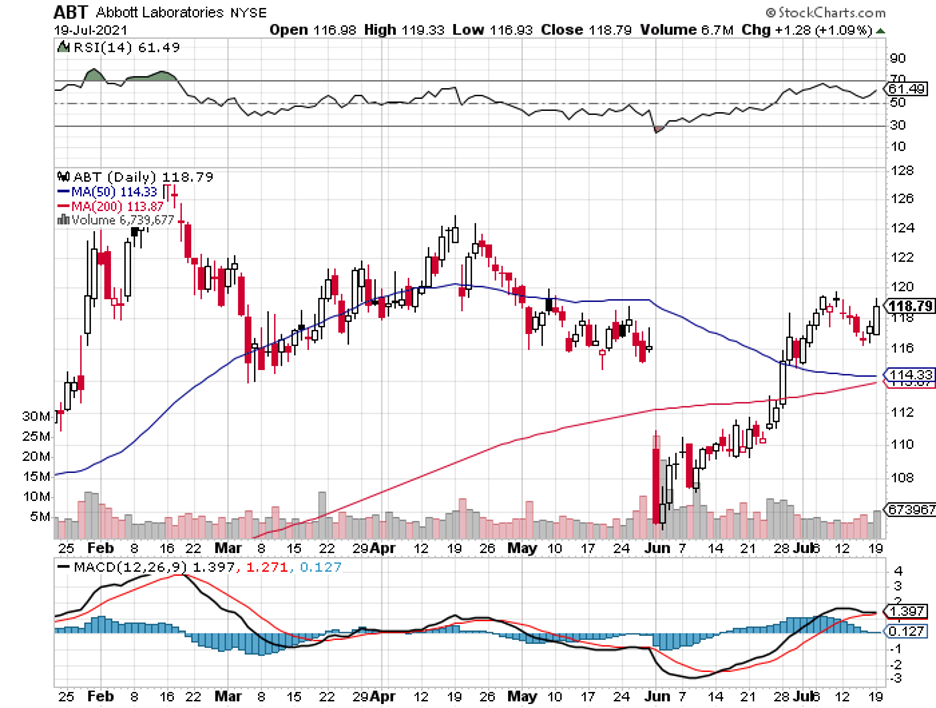
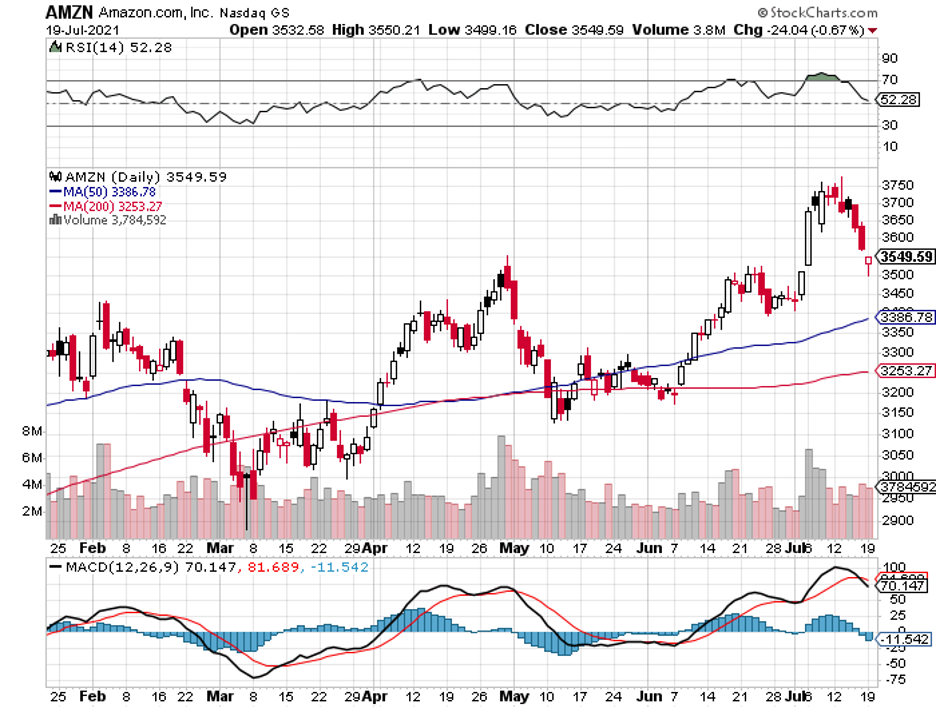
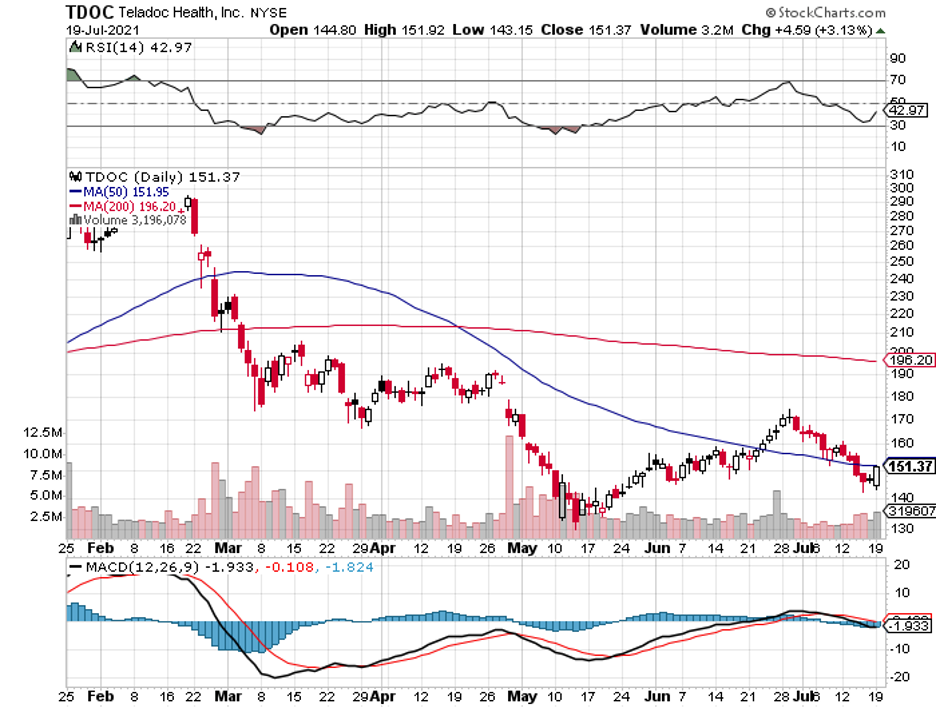
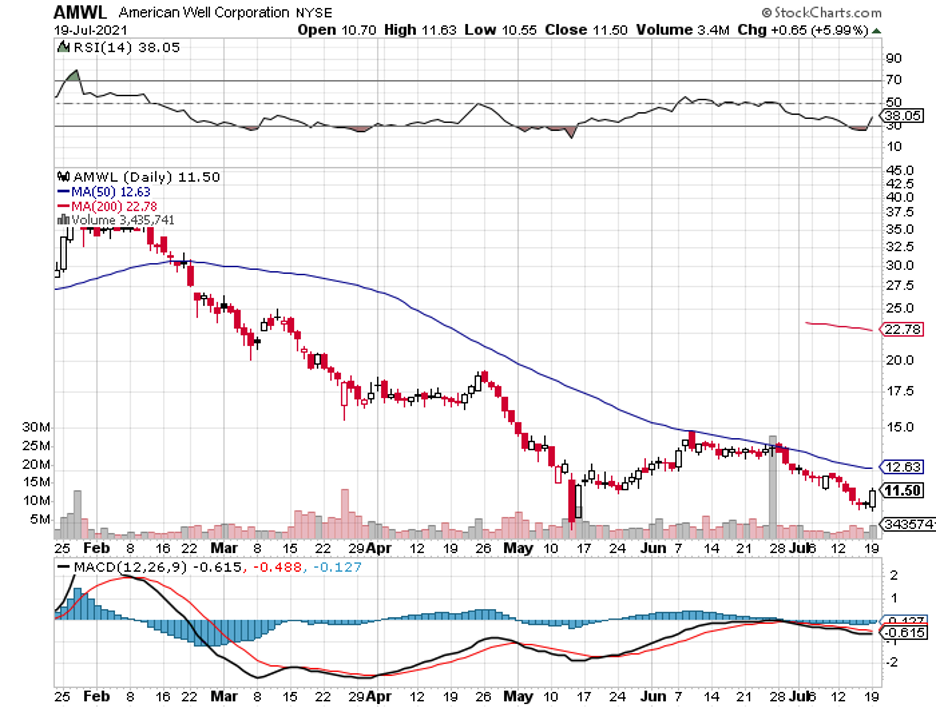
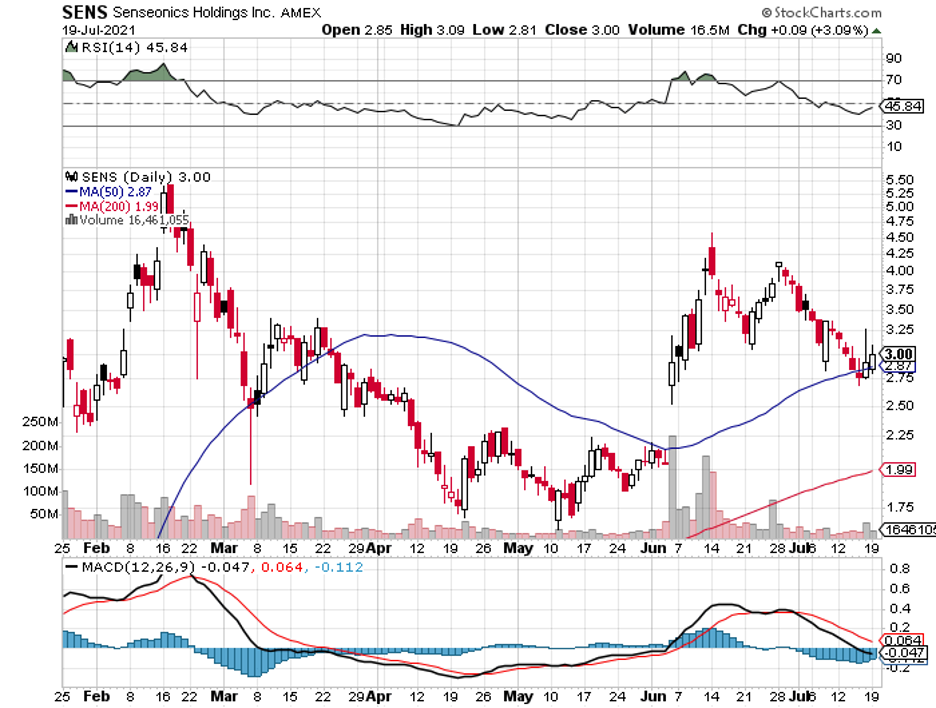
Mad Hedge Biotech & Healthcare Letter
June 22, 2021
Fiat Lux
FEATURED TRADE:
(PRIMED FOR DOMINANCE)
(TDOC), (AMZN), (AMWL), (WMT), (CVS), (ARKK), (TSLA)
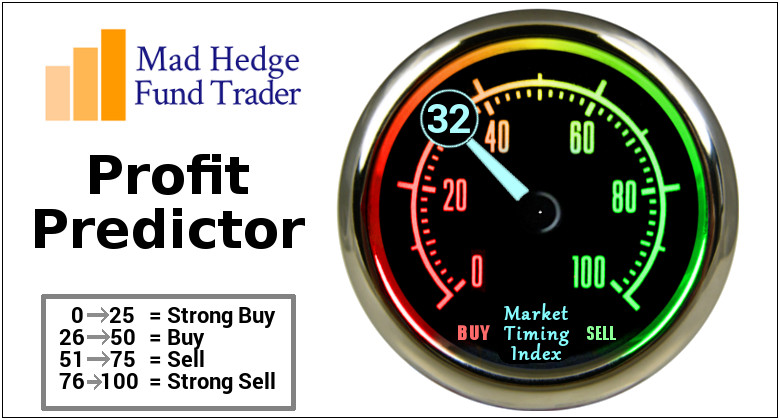
While growth stocks have already begun clawing their way back following the losses they suffered earlier this year, there are still former market favorites struggling to bounce back.
One of them is Teladoc Health (TDOC).
To date, Teladoc is still trading at roughly 40% below its previous highs.
While this can be frustrating for its investors, the current situation might just be an opportune time to add this stock to your portfolio.
Teladoc emerged as the leader in virtual care in 2020 by being at the right place at the right time when the pandemic struck. That year, the company’s revenue rose by a whopping 145% compared to its 2019 performance.
These days though, the stock has lost half of its value. Although that’s definitely a head-scratcher, Teladoc’s 51.5 million paid memberships in the United States alone still make it the most dominant force in this industry.
For a long-term investor, the situation presents a compelling opportunity.
Teladoc is a growing business that’s expanding both in the US and globally. While penetrating more markets would happen over time, the basic footprint has been established. This offers Teladoc much-needed exposure to a massive addressable market.
The global market for telemedicine is estimated to expand from $49.9 billion in 2019 to a jaw-dropping $459.8 billion by 2030.
In North America, which holds roughly 34.4% of the market share in 2020, the telemedicine market generated $19.23 billion during the pandemic.
Taking into consideration Teladoc’s revenue of $967.4 million for its US segments in 2020, it becomes clear that the company is only getting started, as this comprised only 5% of the market size.
If the company maintains its momentum, then the next 10 years would be an incredible journey for Teladoc investors.
Despite the disappointing share price performance of Teladoc in the past months, the company’s actual business has sustained its growth.
Revenue continues to rapidly rise, showing off a 151% growth in the first quarter of 2021.
This impressive growth has prompted Teladoc to boost its full-year revenue guidance to $2 billion, which indicates an 80% year-over-year gain.
Impressive growth has been observed all around, with access fee revenue going up 183% while visit fees climbed 24%.
Considering the size of the market, it no longer comes as a surprise that Teladoc is facing competitive threats.
Amazon (AMZN) and Amwell (AMWL) have recently entered the virtual care market. Even Walmart (WMT) and CVS (CVS) have been working on toppling Teladoc as well.
Despite the competition, Teladoc remains ahead of the pact thanks to its continuous efforts to innovate.
For example, the latest innovation from Teladoc is Primary360.
This product is designed to take virtual healthcare to the next level. It offers personalized service at the patient level. Here’s a preview of how it works.
Traditionally, patients go to their doctors when they discover a health problem. This is a reactive way of dealing with health. In contrast, Primary360 is proactive.
That is, the product monitors the patients individually from annual checkups to ongoing treatments to manage chronic conditions. Through closely monitoring the patients, Teladoc is able to perform earlier diagnoses of potential diseases and help doctors reach better outcomes for treatments.
To better picture the long-term rewards of this company, it’s good to keep in mind that Teladoc is actually the second biggest holding of Cathie Wood’s ARK Innovation ETF (ARKK), next only to Tesla (TSLA).
Teladoc Health emerged as one of the most popular pandemic plays in 2020.
While the stock tumbled when vaccines hit the market, its projected growth trajectory remains promising. In fact, Teladoc’s revenue growth is anticipated to skyrocket over the remainder of this decade, with telemedicine estimated to reach roughly half a trillion dollars by 2030.
For investors on the lookout for long-term plays, Teladoc Health's tumble has presented a good opportunity to add it to your portfolio.
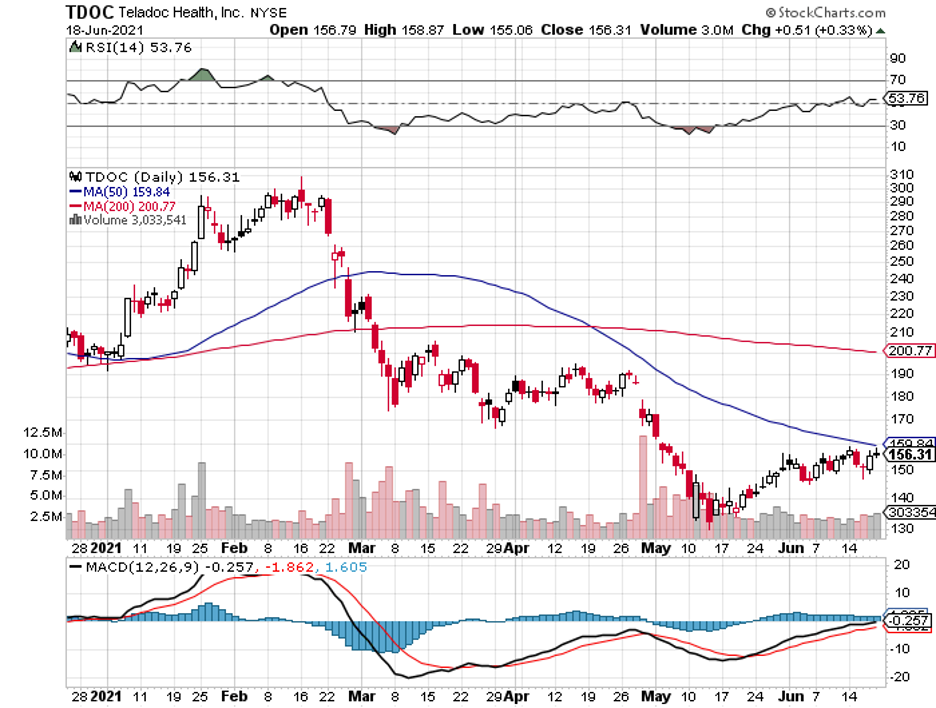
Legal Disclaimer
There is a very high degree of risk involved in trading. Past results are not indicative of future returns. MadHedgeFundTrader.com and all individuals affiliated with this site assume no responsibilities for your trading and investment results. The indicators, strategies, columns, articles and all other features are for educational purposes only and should not be construed as investment advice. Information for futures trading observations are obtained from sources believed to be reliable, but we do not warrant its completeness or accuracy, or warrant any results from the use of the information. Your use of the trading observations is entirely at your own risk and it is your sole responsibility to evaluate the accuracy, completeness and usefulness of the information. You must assess the risk of any trade with your broker and make your own independent decisions regarding any securities mentioned herein. Affiliates of MadHedgeFundTrader.com may have a position or effect transactions in the securities described herein (or options thereon) and/or otherwise employ trading strategies that may be consistent or inconsistent with the provided strategies.
This site uses cookies. By continuing to browse the site, you are agreeing to our use of cookies.
OKLearn moreWe may request cookies to be set on your device. We use cookies to let us know when you visit our websites, how you interact with us, to enrich your user experience, and to customize your relationship with our website.
Click on the different category headings to find out more. You can also change some of your preferences. Note that blocking some types of cookies may impact your experience on our websites and the services we are able to offer.
These cookies are strictly necessary to provide you with services available through our website and to use some of its features.
Because these cookies are strictly necessary to deliver the website, refuseing them will have impact how our site functions. You always can block or delete cookies by changing your browser settings and force blocking all cookies on this website. But this will always prompt you to accept/refuse cookies when revisiting our site.
We fully respect if you want to refuse cookies but to avoid asking you again and again kindly allow us to store a cookie for that. You are free to opt out any time or opt in for other cookies to get a better experience. If you refuse cookies we will remove all set cookies in our domain.
We provide you with a list of stored cookies on your computer in our domain so you can check what we stored. Due to security reasons we are not able to show or modify cookies from other domains. You can check these in your browser security settings.
These cookies collect information that is used either in aggregate form to help us understand how our website is being used or how effective our marketing campaigns are, or to help us customize our website and application for you in order to enhance your experience.
If you do not want that we track your visist to our site you can disable tracking in your browser here:
We also use different external services like Google Webfonts, Google Maps, and external Video providers. Since these providers may collect personal data like your IP address we allow you to block them here. Please be aware that this might heavily reduce the functionality and appearance of our site. Changes will take effect once you reload the page.
Google Webfont Settings:
Google Map Settings:
Vimeo and Youtube video embeds:
